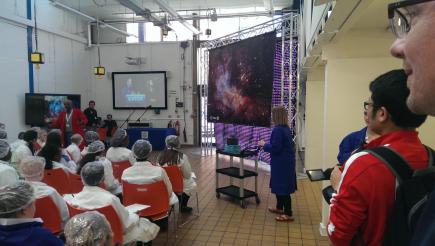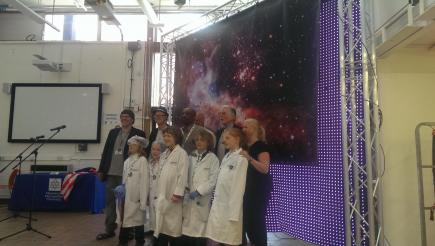The Hubble Space Telescope – which was launched into the Earth’s orbit in 1990 – has been described as ‘sexy’ by a top researcher as Manchester Metropolitan University celebrated its 25th birthday this week.
The apparatus, named after American astronomer Edwin Powell Hubble, has made millions of observations of our solar system and beyond in its existence, contributing to over 10,000 research papers dedicated to extending our understanding of the universe.
The event at MMU featured the unveiling of a new image from the telescope – a giant cluster of about 3,000 stars called Westerlund 2.
Dr Conway Mothobi, Special Projects and Outreach Manager at MMU, commented about the attraction of the telescope to both the scientific community and the public as attendees gathered to wish it a ‘happy birthday’.
“I cannot think of any other piece of equipment which has remained so sexy for 25 years,” he told MM.
“It’s just very difficult to find one because Hubble is so wonderful.”

STAR QUALITY: Attendees gather to view unveiling of new image
The University was chosen as one of only six locations in the UK to reveal the new image, which was unveiled simultaneously at sites worldwide.
Dr Mothobi, who was selected as a Hubble25 Communicator, described it as ‘the most stunning image the world has ever seen’.
Director of Digital Innovation at MMU, Paul Bason, whose department hosted the event, spoke of the attention the celebrations were garnering and how the University hoped to help continue Manchester’s tradition of contributing to science in a broader context..
“The link with NASA and the European Space Agency and this kind of imagery is great, because it draws a different kind of audience to us,” he said.
“We want to be part of establishing Manchester as a centre for innovation in digital technologies.
“We have the Graphene Institute, we’ve got the BBC here, so actually Manchester is a great creative and technological city – it always has been.”
The University hosts a number of outreach programmes to get people in the community interested in science, and Dr Mothobi underlined the importance of making projects such as Hubble accessible to provide inspiration.
“I believe that there are a lot of people who do not have proper access to education as a kick off, then for the science side of things, there’s even less access,” he said.
“It should be natural for people to end up coming to university, but one of the reasons is because the inspiration to go down that route is not there.
“We as universities have in the past failed to give that inspiration.”
In attendance at the event were children from Kids in Space, a Stretford-based community project, along with 32 year seven students from Manchester Communication Academy.

STARS OF THE FUTURE? Hoards of children attended the event
Mr Oliver Smith, a science teacher at MCA, said: “It’s been really good. It’s really nice to take them out of school and get them learning in a different environment.
“It re-energises their enthusiasm for science, and to get them doing something different and getting them interested in science is key really.”
The students took part in numerous activates before the big reveal, including building their own Discovery space shuttle complete with Hubble payload.
Dr Mothobi was optimistic about the benefits of the children’s visit, and explained how he felt it was important for the children to continue their engagement in science after the event.
He said: “I personally do not think it is a good thing to excite kids with science and then turn around when the event is done and sort of forget about them.
“So we are going to continue this project with those schools, because now what they’ll do they are going to look at actually the science of Hubble.”
Dr Mothobi also expressed a wish to share with the public an understanding of the role space exploration plays in our lives.
“That is an important thing, because they can then connect what is happening out there in space, and actually that Earth is part of space,” he said.
“Some of the problems that we are addressing here on Earth are actually problems which can be solved using the knowledge which comes from the space exploration endeavours that we have.”
He gave the example of dust storms being observed on Mars, research which would have taken much longer on Earth due to atmospheric phenomena as simple and everyday as clouds.
Discussing the image which had been revealed, Dr Mothobi pointed out that when it is received from Hubble it is raw and unprocessed, lacking the ‘Wow!’ factor.
The European Space Agency has produced a programme named the FITS Liberator, which allows people to download and process these raw images themselves.
Dr Mothobi explained: “With that, guess what, you can download one of these raw images from Hubble, play along with it and you too could produce a wonderful image like we saw today.
“If we can actually move that to a point whereby young people can start playing with that then we’ll have done a good job.”
He discussed the way in which large scientific projects, such as the Hubble Space, captured the public’s imagination.
“The Hubble telescope produces images that are fantastic for scientists – it is absolutely wonderful what we learn from them,” he said.
“But at the same time they are fantastic for almost everyone else – people who see them.”